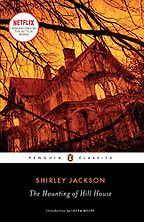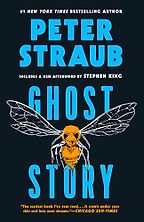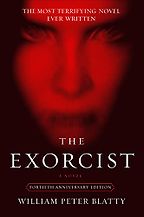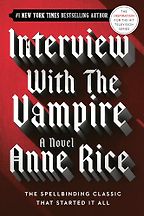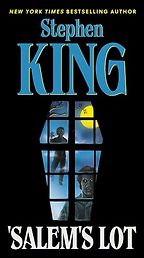Looking down the list of books you’ve chosen, it looks like a fantastic set of horror books. Would you say these are some of the best ones out there? Tell me about your criteria for picking them.
I would say these are some of the bedrock horror books. There are so many, like Mary Shelley’s Frankenstein, or Edgar Allan Poe. I would also classify Beloved as a horror novel, but it’s not—or you won’t find it in that section in a bookshop. That’s the modern thinking of horror sometimes, ‘Where does it fit on a shelf?’— as opposed to the content.
I chose these books because they’re books that a lot of horror writers and a lot of horror readers have read or have knowledge of. It’s an all-white list because, for a very long time, a lot of people were excluded from big publishing and books getting out there. As time has gone on, horror has opened up to different cultures. There are more women, more writers of color. But these are some of the early icons that form the bedrock.
And they’re a lot of fun to read?
Yes, absolutely. All of them have now had films or TV shows made about them, and those are in the collective consciousness as well. They have inspired writers, even if you are a writer of color or you’re queer. I mean, in one of the books I’ve chosen, Interview with the Vampire, you do wonder about the relationships. If you read more books by Anne Rice, you do see how certain vampires were made, their sexuality, and they are a little gender fluid…
These books have been a huge inspiration for people—of all backgrounds, genders, sex and sexual orientation—who are writing today.
My approach to reading horror has been quite eclectic, so I don’t have much of an overview of the genre. Could you tell me about the evolution of horror in the United States?
Obviously, the United States was colonized by the English (and French and Spanish) and a lot of established folklore and tales were brought over, including Mary Shelley. But it was indigenous land and they had their own stories, like the wendigo from Algonquian folklore. Indigenous storytelling is very different.
As I said, publishing in the United States has been predominantly white, but now you have people like Stephen Graham Jones, who is an indigenous horror writer. He’s doing amazing work. There’s Rebecca Roanhorse, though she does more fantasy and sci fi. Shane Hawk also did an anthology with lots of great indigenous stories and writers—similar to my book, Latin American Shared Stories, where I gather a lot of writers from Latin America. There’s just a wealth of of storytelling. Horror has evolved as the world has evolved, as cultures have mixed and sometimes clashed. This country is a melting pot, and the storytelling reflects that.
Horror also captures some of the history of the United States. There are Black writers writing about the Black experience, like Tananarive Due, for example, who wrote The Reformatory about the school her great-uncle was sent to. You have a lot of writers writing about their experience, which is great. It’s become this way of people expressing themselves and their personal evolution.
When I see prize shortlists—like the Bram Stoker awards—it seems like Hispanic writers are very strong in horror at the moment. Is there a reason for that?
It’s because there are more opportunities for other cultures to tell their stories and to get them out there, and they’re different. I mentioned Anne Rice and Interview with the Vampire. If we go further back, we’ve got Bram Stoker (1847-1912), who is Irish, writing Dracula. That story has inspired a ton of vampire stories. You now have writers from all over telling different types of vampire stories—because a lot of cultures have their own vampire or their own description of a bloodsucker and people are hungry for new takes on old tropes.
I’m Mexican-American and we have our creatures and folk tales.
Yes, and you’ve been twice nominated for the Bram Stoker awards. Do your books look to Mexican myths? Tell me what they’re about.
So The Goddess of Filth is a possession story, like The Exorcist. That concept seemed very real to me. I wanted to write about girls coming of age, when your body has changed. You’re learning about yourself, about your sexuality, and having agency. It’s about someone who’s becoming possessed not by a demon, but with confidence. So I used an Aztec goddess and her mythology. The girls do a seance, trying to call something up and one of them is possessed by a very powerful, ancient goddess. Her mom thinks she’s doing drugs or drinking, and a priest is called, all those things.
Then with The Queen of the Cicadas, which was nominated for the Bram Stoker for best novel, I wanted to do a take on the Bloody Mary urban legends. Because urban legends are also part of American horror, you see it in films and in what is called ‘creepypasta’—these stories that are told on the internet which aren’t true, but are fun. Again, I wanted to use a powerful deity to tell this ghost story about a woman who was murdered in an attack by other women, and her rebirth and transformation.
My book The Haunting of Alejandra is about postnatal depression, mental health, motherhood and marriage, and I use La Llorona, a ghost story in my culture, to talk about them. It’s a way of talking about difficult things in a way people can relate to. They think, ‘Wow, I felt like that. I’ve experienced that.’ But it’s not hitting them over the head. It’s entertaining, even if it is painful or something people don’t want to talk about. Those are the type of things I think horror really does well, shining a light on difficult topics.
Let’s turn to the classics of modern American horror that you’re recommending. First up, we’ve got The Haunting of Hill House by Shirley Jackson, which was published in 1959.
Shirley Jackson came on the scene into a very male-dominated world of publishing. It took a while for women to get to write and to be published and to be acknowledged.
The Haunting of Hill House is a ghost story. She was inspired by people going into places to hold seances and get in touch with ghosts or spirits. She wanted to write a story about it, which she did, and she did it really well. As always in horror, it isn’t just about the ghost. It’s about the people who have come to this place. It captures what’s going on internally with these individuals who are at the house, and one particular woman…[SPOILER ALERT] The way it ends, it’s so tragic. Death and grief are tragic, but sometimes not being able to be yourself or live truthfully is just as tragic.
And the focus is on this one house, Hill House?
Yes, and that’s also the beauty of it. It’s not a bunch of ghosts or zombies or monsters running around. Everything is really internal. The heart of horror is what’s happening beyond the door, behind the windows when they’re closed and the drapes are drawn. What’s happening beyond a person’s smile or wave or what they’re wearing? There’s a whole other world inside, like a house, and that’s what I really love about ghost stories and hauntings.
It’s the same in one of the other books we’re going to discuss, Ghost Story. Memories, regret, fear—those are ghosts too. They’re internal ghosts that we carry from the past. These ghost stories are what a lot of modern writers are tapping into because they are the books that people know about and have read.
Let’s turn to that book next. This is Ghost Story by Peter Straub, published in 1979.
Again, it’s about hidden truths. So there is a group of men who sit around and tell a story every night. They’re called the Chowder Society. They sit around in a darkened room, having their drinks, telling their stories and reliving the past. Who knows what is true and what isn’t? It’s about camaraderie and these guys coming together.
There is a guy whose name is Don, and he comes back to this small town in upstate New York after his uncle dies. People going back to a place is another way that horror isolates people, because if you’ve been separated from your hometown, or you’ve left, a lot of times it’s for a reason. He comes back and is introduced to this society. You’re hearing these stories, which are frightening. One of the stories is about an older boy who was molesting the younger ones. That’s particularly uncomfortable. Child abuse is one of those things that you wouldn’t necessarily want to write a book about, even though it is a lived experience for people. In the context of a horror story, you can broach the subject in a way that isn’t so traumatic.
Books now have trigger warnings. They’ll say sexual assault, or suicide, which like child abuse can be triggering for people. It’s a really hard subject, but in the context of a ghost story…Why is this place haunted? Well, someone took their life. It’s a really sad thing, but why did they take their life? Why would the spirit of someone who took their life in this particular house in this particular way still be lingering here?
In this particular ghost story, it’s someone who’s capable of sexually assaulting other children. What kind of energy would they have? Would that kind of spirit be able to linger? Because it is evil. When you think about evils in the world, that’s probably one of the top ones, harming a child in that way.
So again, you have a tough subject that can be broached in a way that isn’t just, ‘Hey, I’m going to tell you about rape or sexual assault.’ As I said, in my book, I talk about postnatal depression, which can be quite insidious, emotionally and mentally, because we’re brought up to think that motherhood should be happy: ‘It’s the best thing that could ever happen to you! There are so many people who want children! You have a baby and you’re ungrateful!’ It can be quite suffocating, but it’s not the kind of thing people are going to talk about.
People aren’t always going to talk about suicide or sexual assault either, but in the context of a horror story, we can tease apart those complicated emotions. That’s what I love so much about horror, that it can be healing and unifying. There are a lot of novels people have read that help digest some real-life horrors—whether it’s war or racism. You can see another perspective.
So in this story, is it just these men talking about the past, or is there something happening in the present as well?
All of these weird happenings start occurring in the neighborhood. As with any good ghost story, you wonder, ‘Is it real or is it in the mind? Is it your emotions or is it a physical manifestation of evil?’ That’s the mystery you unravel. There’s the unreliable narrator. This bad kid or someone who’s killed themselves, what is this thing that’s in this house or in this neighborhood? What are we tap dancing around, telling these stories? Is it real? Or is it just a story? You just never know. It’s like sitting around a campfire and people are telling stories. ‘Did you know that in these very woods where we’re standing, a person did…?’ And you might sit around and think, ‘Did it really happen?’ And then you go to bed and you hear crunching of leaves or branches. ‘Is it just a fox, or is there something in these woods, like the story said?’
There’s also a love interest in the book, this beautiful woman. You’re drawn in by these characters and what’s happening in this society. That’s what’s so great about these ghost stories—they have the ability to draw you into the emotions and the thoughts of these individuals, and what’s happening beyond the ghosts or the scares.
Let’s turn now to The Exorcist (1971) by William Peter Blatty, which I believe was based on a true story.
Yes, it was inspired by a real exorcism. It starts with a young girl playing with a Ouija board. It’s kind of friendly, ‘Oh, haha! It’s a game. It’s not real.’ And then things get real. We know that there are exorcists in the church, and a belief in good versus evil, the Devil, spirits. This girl gets possessed by one particular demon, Pazuzu. He’s actually a Mesopotamian demon; you can see his amulet at the British Museum. I wrote a book called Tales of the Dark Feminine, and Pazuzu wasn’t always looked on as evil. But it’s Christianity versus the pagan and in The Exorcist the demonic entering into this young girl playing a supposedly innocent game.
She’s at an age where she’s not a child, but she’s not yet a young woman. It’s quite frightening. It’s like, ‘Who is safe from evil?’ We often think of young girls as very vulnerable. How do you keep them safe? You’re not going to possess a baby, because a baby can’t do anything or say anything. What’s the next scariest thing? A young girl on the cusp of becoming a woman, a tween.
At first, the book didn’t do so well. It took a while. Then the film came out, and that was it. It was horrifying. People were physically sick. It was a smash hit. It’s one of my favorite films. It’s really well done.
Is The Exorcist the scariest of the books on the list?
Yes, by far.
Let’s turn to Interview with the Vampire (1976) by Anne Rice, which you mentioned earlier. What more can you tell me about this book?
There’s a levity to Anne’s writing, but also a sexiness. She brings you into the world of these vampires who have lived for ages. One of the characters, Lestat, is quite decadent. He’s completely over the top—people love him or hate him—and he just never dies. I’ve read all the books in the series, and I’ve watched the films, and he’s quite extravagant, but that’s what’s great. Anne Rice took the vampire trope and made it something completely unique and a bit sexy.
At the other end of the spectrum is Salem’s Lot.
Yes, tell me about Salem’s Lot, Stephen King’s second novel.
This is not a sexy vampire, but quite a frightening one. Salem’s Lot is a very scary book. Whereas in Dracula, and especially in Interview with the Vampire, the vampires are quite human, the vampire in Salem’s Lot is more like a true creature. It’s an absolute bloodsucker, just intent on eating and killing the people in this small town. Anyone who has seen the series from the 1970s will know it’s just so frightening. There’s a scene with a little boy at the window, flying. Again, using children…Anne Rice, later in the series, does have a child who becomes a vampire, but she’s quite pretty. She’s in a child’s body, but she develops as a woman. Whereas this boy in Salem’s Lot… It’s very dark and grim and gritty. There’s also a priest who doesn’t have the wholesomeness you see in other portrayals of priests.
I liked how Stephen King and Anne Rice both changed up the vampire. It’s about how different the vampire can be, which is the fun part of horror. Nowadays, you have writers from all cultures writing about their own kind of vampires.
King’s original idea for Salem’s Lot was that a vampire would arrive in New York City, wasn’t it? I was reading an interview with him, and apparently, it was his wife who said to him, ‘You’ve got to set it in a rural community to be more scary.’
It’s about the isolation. That feeling of isolation is a part of horror, whether it’s in the mind or physically in a rural area. It amps up the fear because where do you run? Where do you hide?
If you’re in a haunted house, if you see something, and there are other people around, you might not want to say something, because what are they experiencing? Are they seeing it? Are they going to think I’m mad?
So Salem’s Lot is probably the second scariest book on this list, after The Exorcist?
Yes, and I would say that, for me, Interview with the Vampire is probably the least scary. It’s just a fun book. It’s dark, but it’s not the same darkness as you get with Stephen King’s books, some of which are very bleak, or with some contemporary books written by Black writers about their history. There was a recent horror film that came out called Sinners, which is excellent. It’s set at a time when there’s a lot of racial tension, and you have these Irish vampires trying to get let in. It’s a really good movie, a modern take on the vampire that I absolutely loved.
Lastly, tell me a bit more about the book you’ve just edited, Latin American Shared Stories.
A lot of the stories I’ve talked about here are classics, but as I said earlier, publishing has opened up, times have changed and you have writers from different cultures with different stories, folk tales, and urban legends. They have the ability now to reach a wider audience and tell them about these things. For example, there’s one story in the book called “Sucker.” Alyssa Alessi takes a vampire story and sets it in her neighborhood, in a city, in a club. It’s vampires out and about doing their thing, like Anne Rice did with Interview with the Vampire. They’re everywhere, but you just don’t see them—or maybe you do, and you’re attracted to that.
I wanted to get really good writers from across cultures, experiences, genders, to write stories. Whether it’s supernatural, whether it’s folklore, it’s something that challenges you. It includes speculative fiction, but more on the spooky, supernatural side of the spectrum.
These bedrock books are great. However, it’s nice to also say ‘Yes, we were inspired by those books. However, we also have tales. We also have our own lived experiences and our fears and emotions and our way of tackling difficult subjects.’ So that’s what I wanted to do with Latin American Shared Stories. I wanted to open the conversation to a wider audience, but also more writers, and introduce people who like speculative fiction to different voices and different experiences.
So are the stories from all over Latin America?
Yes. It’s writers from a ton of different places because every culture has a different take on a vampire or ghosts and different practices. That’s interesting to me, too, because it adds to the fear factor. If someone asks, ‘Did you know about this creature?’ and you didn’t and they tell you about it, then the next time you walk alone, you might think about it…
But the stories are written in English?
Yes. There are some Spanish words, but Google is everybody’s companion these days, so it isn’t challenging to read. One story, “Nacho” by Daniel Olivas, talks about different foods he’s eating and, again, you can easily Google to get what he’s talking about, or certain cultural references. That’s what I like, that it will challenge readers to think, ‘Oh, I’ve never heard of that practice or that belief. Let me go look it up. Let me explore. I’ve never heard of that folk tale. Let me go and find out more. I love that story. Let me go read more from this writer.’
For me, that’s exciting, to open the doors in publishing and in storytelling. Because the original books here are all by white Americans. Times have changed, and so publishing should change, and we’re better for it. It’s better for us to understand more about each other, as opposed to being divided and focusing on the differences. What makes us human? Every single person knows fear—what we fear is different, but it is shared across humanity. We all know hunger. We know love. And we all bleed the same colour.
Storytelling brings us together. Let’s understand more about each other and where we’ve come from, because I think if we did understand more about each other on a human level, there would be a lot less fear.
Interview by Sophie Roell, Editor
November 9, 2025. Updated: November 27, 2025
Five Books aims to keep its book recommendations and interviews up to date. If you are the interviewee and would like to update your choice of books (or even just what you say about them) please email us at [email protected]
Five Books interviews are expensive to produce. If you've enjoyed this interview, please support us by donating a small amount.


